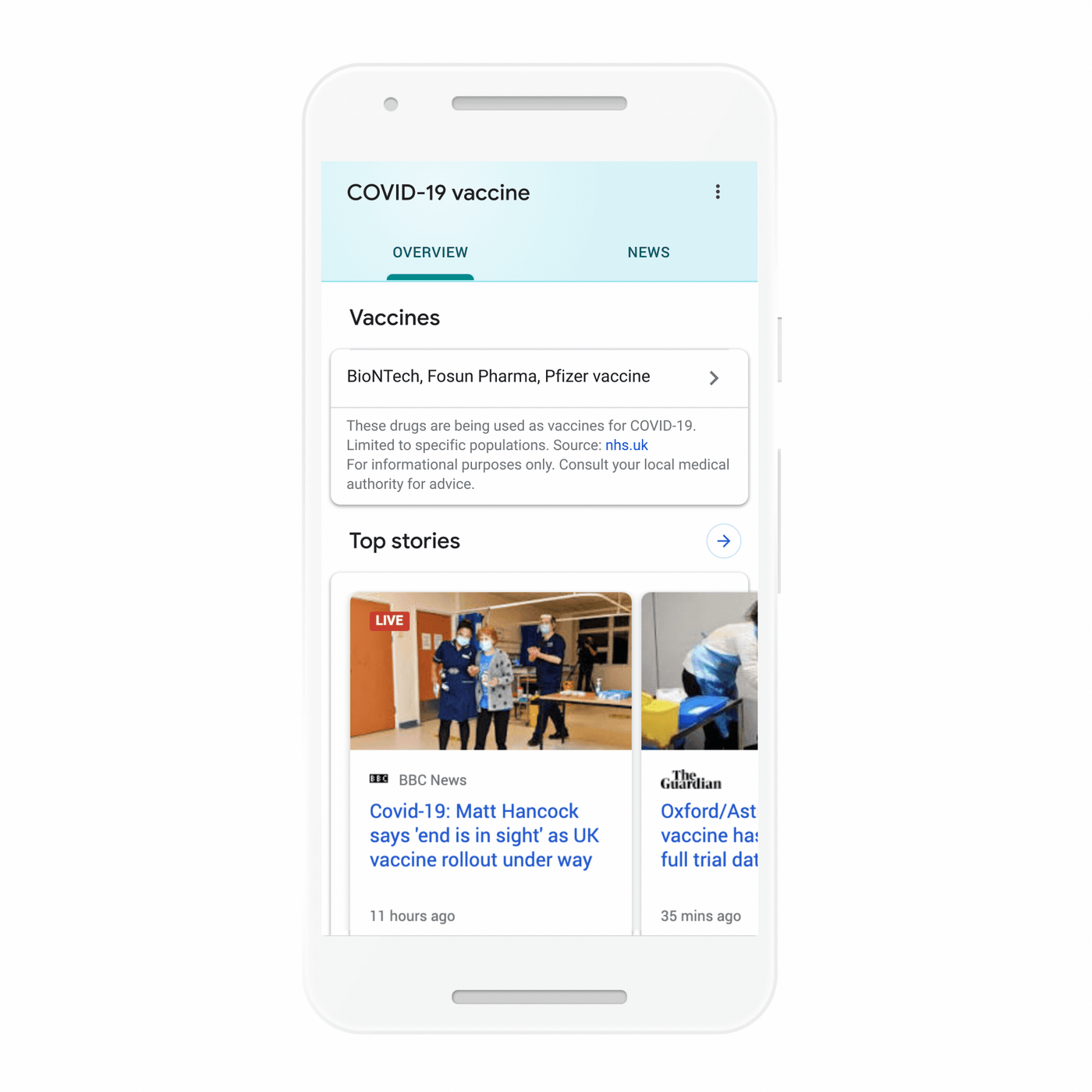Read this post in English. // Blog en inglés aquí.
A medida que más personas tienen acceso a la vacuna contra el COVID-19, estamos haciendo más fácil aprender por qué, cuándo y dónde pueden vacunarse. Hoy en día, puedes encontrar ubicaciones de vacunación en Google Maps y en búsquedas de Google en los Estados Unidos, Canadá, Francia, Chile, India y Singapur.
Aún así, queda mucho trabajo por delante para asegurarnos de que todos los que quieran vacunarse puedan hacerlo. En los Estados Unidos, COVID-19 ha afectado de manera desproporcionada a las poblaciones Afroamericanas y Latinas, aun así estos grupos tienen índices más bajos de vacunación. Las vacunas pueden ser más difíciles de acceder para personas debido a factores como el lugar donde viven, la distancia que deben conducir hasta un lugar de vacunación y si tienen acceso confiable a Internet para reservar una cita. Y a nivel mundial, podrían pasar años antes de que algunos países incluso tengan suficientes vacunas.
Superar la pandemia requerirá un esfuerzo coordinado a escala mundial. Para hacer nuestra parte, hoy anunciamos que estamos proporcionando 250,000 vacunas contra el COVID-19 a países que las necesitan, ayudando a financiar sitios emergentes de vacunas en los Estados Unidos y comprometiendo $250 millones adicionales en Ad Grants para conectar a las personas con información precisa sobre la vacuna.
Asegurando vacunas para personas en todo el mundo
Hoy, Gavi, The Vaccine Alliance, lanzó una campaña para obtener fondos adicionales para asegurar vacunas para países de ingresos medianos y bajos. Google.org está financiando vacunas para 250,000 personas y proporcionando a Gavi asistencia técnica gratuita para acelerar la distribución mundial. También estamos iniciando una campaña de donaciones para empleados, y tanto Gavi Matching Fund como Google.org igualarán cada donación para triplicar el impacto.
Desde febrero, hemos estado proporcionando información relacionada con las vacunas para ayudar a Gavi a educar mejor a las comunidades sobre la vacuna contra el COVID-19. Han utilizado esa información para crear contenido educativo que llega a más de medio millón de personas cada día. Ahora estamos comprometiendo $15 millones en Ad Grants para ayudar a Gavi a aprovechar estos esfuerzos y ampliar su campaña de recaudación de fondos.
Financiando sitios temporales de vacunación y haciendo más fácil la reservación de citas
Casi una cuarta parte de las personas en los Estados Unidos ahora están vacunadas. Sin embargo, sabemos que los índices de vacunación varían según la geografía y la comunidad. Llegar a todos requerirá una asociación con organizaciones comunitarias y centros de salud locales que tengan experiencia en el terreno y la confianza de las personas a las que sirven.
Google.org está proporcionando $2.5 millones en subvenciones a Partners in Health, Stop the Spread y Team Rubicon, que están trabajando directamente con más de 500 organizaciones comunitarias para servir a las comunidades afroamericanas, latinas y rurales. Este financiamiento se destinará a esfuerzos, como sitios de vacunación emergentes.
Para asegurarse de que más personas, especialmente aquellas con acceso limitado a Internet, puedan inscribirse para recibir una vacuna,Google Cloud está lanzando un ampliado agente virtual como parte de suSolución de impacto de vacuna inteligente (IVI). Las personas podrán programar citas para vacunas y hacer preguntas comunes a través de un agente virtual, en hasta 28 idiomas y dialectos, a través de chat, texto, web, móvil o por teléfono.
Compromiso de $250 millones para conectar a las comunidades con información confiable sobre vacunas
Desde el comienzo de la pandemia, cientos de empleados de Google han ayudado a las organizaciones a conectar a las personas con información actualizada, especialmente en comunidades a las que no suelen llegar los anuncios de servicios públicos convencionales.
Por ejemplo, estamos trabajando con UnidosUS en una campaña de vacunación bilingüe que hasta la fecha ha llegado a más de dos millones de personas en las comunidades más afectadas en Miami, Chicago, Houston, Nueva York y Los Ángeles. Hemos realizado una investigación con la Organización Mundial de la Salud sobre qué información mejora la confianza en las vacunas, y los gobiernos de todo el mundo están utilizando estos conocimientos para informar sus anuncios de servicio público.
Para expandir este trabajo, estamos comprometiendo $250 millones adicionales en Ad Grants a gobiernos, organizaciones comunitarias y de salud pública, incluida la OMS, que financiarán más de 2,500 millones de anuncios de servicio público relacionados con vacunas. Esto eleva nuestro compromiso total para los anuncios de servicio público relacionados con COVID a más de $800 millones.
Como hemos aprendido durante la pandemia, nadie está a salvo del COVID-19 hasta que todos estén a salvo. Llevar las vacunas a todo el mundo es un reto desafiante, pero necesario. Seguiremos haciendo nuestra parte y trabajando juntos hasta que lleguemos a lograrlo.
Sintoniza YouTube el 8 de mayo a las 5 p.m. PST / 8 p.m. EST para ver Vax Live: The Concert to Reunite the World, una campaña de recaudación de fondos para vacunar a los trabajadores de la salud que prestan servicios en la primera línea de la pandemia.
